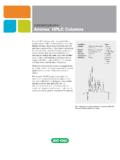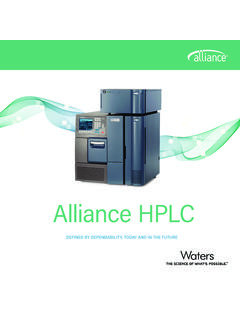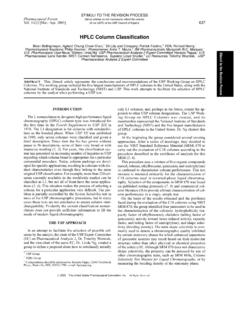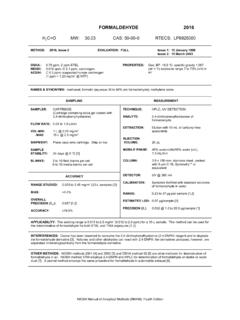Transcription of HPLC DETECTORS: A BRIEF REVIEW - Instituto de …
1 hplc detectors : A BRIEF REVIEWM ichael SwartzSynomics Pharmaceutical Services, LLC, Wareham, Massachusetts&In an hplc system the detector is the component responsible for turning a physical or chemi-cal attribute into a measureable signal corresponding to concentration or identity.[1,2]In the earlydays of hplc , detection was often carried out by collecting fractions and analyzing them wasn t until the 1940 s and 1950 s that the first online detectors for hplc were introduced.[3,4]Certainly an improvement over off-line approaches, sensitivity was an issue. The search for moresensitive universal detectors for hplc led researchers to adapt GC detectors for use in hplc ,[5 8]but the removal of the hplc mobile phase originally limited applicability. However, in the 1960sthe first ultraviolet detector for hplc was introduced,[9]and subsequent improvements in designled to better sensitivity[10]and improvements such as variable wavelength and diode array detec-tors.
2 While a truly universal hplc detector with GC=FID levels of sensitivity is still elusive, manydifferent types of detectors have been developed that have been very successful for a wide variety ofgeneral or specific hplc applications. To assist in choosing the proper hplc detector for a givenapplication, this REVIEW describes the principles and attributes of many of the common hplc detec-tors in use today, and compares and contrasts the advantages and disadvantages of the variousdetectors discussed where appropriate. For additional detail on the hplc detectors addressed here,the reader is encouraged to consult the references in each section along with additional generalreviews.[11,12]Keywordschromatogr aphy, detectors , REVIEW , selection, typeINTRODUCTIOND etectors for hplc are designed to take advantage of some physical orchemical attribute of either the solute or mobile phase in the chromato-graphic process in one of four ways:[2].
3 A bulk property or differential specific phase techniquesAddress correspondence to Michael Swartz, Synomics Pharmaceutical Services, LLC, 790 MainStreet, Wareham, MA 02571-1037, USA. E-mail: of Liquid Chromatography & Related Technologies, 33:1130 1150, 2010 Copyright#Taylor & Francis Group, LLCISSN: 1082-6076 print/1520-572X onlineDOI: By: [Consortio Colombia] At: 16:30 24 July 2010 Bulk property detectors are the most universal detectors for hplc asthey measure properties common to all analytes by measuring differencesin the mobile phase with and without the sample. One of the most com-mon bulk property detectors is the refractive index detector. Given the uni-versal nature of bulk property detectors , they respond to all analytes,placing more emphasis on the selectivity of the chromatographic are, however, inherently somewhat limited in sensitivity since they arethe chromatographic equivalent of determining the weight of a sailor byweighing the battleship before and after the sailor departs for shore specific property detectors respond to a characteristic that isunique to an analyte.
4 The UV detector is the most common example of ananalyte specific property detector, responding to analytes that absorb UVlight at a particular wavelength. UV detectors are usually thought of as some-what specific, responding only to compounds with chromophores, but at lowUV wavelengths (<210 nm), where just about every organic compoundsabsorb, UV detectors are actually somewhat universal. Other analyte specificdetectors include fluorescence, conductivity, and phase modification detectors change the mobile phasepost-column to induce a change in the properties of the analyte, forexample, by creating particles suspended in a gas phase. Evaporative lightscattering and corona discharge detectors fit into this category. Pre- or post-column derivatization of the analyte is also sometimes considered to fitinto this category, but is outside the scope of this REVIEW and will not bediscussed here.
5 [13]Hyphenated techniques refer to the coupling of a separate inde-pendent analytical technology to an hplc system. The most commonis mass spectrometry (LC-MS), and technologies such as infrared spec-trometry (LC-IR) and nuclear magnetic resonance (LC-NMR) havealso been used. While it can be argued that MS is seeing more andmore use as a routine hplc detector, good reviews of its use as well asother hyphenated techniques are available and can be consulted for moreinformation.[14 16]There are many characteristics to consider when choosing a detector,and Table 1 lists some of them. Since no one detector has all of these char-acteristics, over time a multitude of detectors have been designed, pro-duced, and sold to answer one particular challenge or another. Ease ofuse, predictability, and reproducibility are all very important characteristics;however, recently there is an increased emphasis on the flow cellcontribution to band broadening and faster detector responses.
6 Thisemphasis is due to new, low dispersion ultra high performance liquidchromatography (UHPLC) systems designed to take full advantage ofsub-twomm particle size column packings.[17,18]A common rule of thumbsays that for good peak integration, a minimum of 20 points should beHPLC Detectors1131 Downloaded By: [Consortio Colombia] At: 16:30 24 July 2010collected across the peak. With the chromatographic efficiency of sub-twomm particle size column packings often resulting in peaks that are less thana second wide, faster data rates, as illustrated in Figure 1 are required tomaintain good integration, sensitivity, and resolution. Narrower peaks willalso require smaller volume detector flow cells to maintain peak concen-tration, and this lower dispersion should not come at a loss of signal. Manydetectors, including UV, PDA, FL, ELSD, and CAD are commercially avail-able in both hplc and UHPLC version depending upon the 2 further illustrates the effect of sampling rate on sensitivity and res-olution.
7 Some additional considerations to be made when selecting a detec-tor are summarized in Table 2. Most of the considerations in Table 2 arerelatively straight forward, however the use of complimentary or orthog-onal detectors used in combinations (series or parallel, depending uponbackpressure limitations and=or whether or not they are destructive)should be noted as it is gaining in popularity, particularly in drug discoveryor other screening-type applications. The advantages of using orthogonaldetectors is shown in Figure 3, where the differences in response for a UVFIGURE 1 Affect of data rate on peak shape for narrow UHPLC peaks. (Figure used with permissionfrom Advanstar Communications=LCGC Magazine.)TABLE 1 Desired Detector sensitivity and reproducible, predictable to all solutes, or have predictable linear dynamic range; Response that increases linearly with the amount of unaffected by changes in temperature and mobile phase independently of the mobile contribute to extra-column band and convenient to of the qualitative and quantitative information on the detected response1132M.
8 SwartzDownloaded By: [Consortio Colombia] At: 16:30 24 July 2010(214 nm), evaporative light scattering detector (ELSD), and MS (positiveelectrospray ionization) can be seen for some model analytes. Table 3lists some properties of the common hplc detectors in use today, and asummary of some of their key attributes is presented in Table DETECTORSThe UV-visible absorbance detector is the most common hplc detec-tor in use today since many compounds of interest absorb in the UV(or visible) region (from 190 600 nm). Sample concentration, output asabsorbance, is determined by the fraction of light transmitted throughthe detector cell by Beer s Law:A log I0=I Ebcwhere A is absorbance, I0is the incident light intensity, I is the intensity ofthe transmitted light,eis the molar extinction coefficient of the sample, b isFIGURE 2 Affect of data rate on sensitivity and resolution using CAD20 Hz versus 100 Hz.
9 Reversedphase C18separation ( 50 mm), mL=min. at 40 C. Mobile phase: 10%ACN, 50 mM ammoniumformate, adjust to pH 3 with formic acid. (Figure courtesy of ESA, Inc., Chelmsford, MA.)TABLE 2 Example Detector Selection nature of analytes and potential of detection=quantitation and=or cost of with hplc =UHPLC number of different assays to be and Orthogonal DetectionHPLC Detectors1133 Downloaded By: [Consortio Colombia] At: 16:30 24 July 2010the path length of the cell in cm, and c is the molar sample absorbance occurs as a result of the transition of electrons fromp!p ,n!p ,or n!r molecular orbitals; most aromatic compounds absorbstrongly at or below 260 nm, compounds with one or more double bonds( , carbonyls, olefins) at 215 nm, and aliphatic compounds 205 5 lists some of the more common UV chromophores and their molarextinction coefficients.[19,20]Mobile phase solvent and buffer selection isalso important for optimum UV sensitivity and linearity; UV cutoffs (thewavelength at which the solvent absorbs) become particularly significantat low are three different types of UV detectors : fixed wavelength detec-tors that rely on distinct wavelengths, and variable and photodiode arraydetectors that rely on one or more wavelengths generated from a broadspectrum lamp.
10 Fixed wavelength detectors , the backbone of early hplc systems, are cheap and simple, but are in limited use today. The most com-mon fixed wavelength detectors use the 254 nm output from a low pressuremercury lamp, the reason many variable wavelength and photodiodearray applications today still use this wavelength out of sheer wavelength detectors can be tuned to operate at the absor-bance maximum of an analyte or at a wavelength that provides more selec-tivity. They can also be programmed to change wavelengths during achromatographic run to compensate for response of different a variable wavelength detector, light from a broad spectrum (for UVFIGURE 3 Example of orthogonal detection in UHPLC. The three detectors (UV @ 214 nm, ELSD,and MS with positive electrospray) provide complimentary information for the test mix sample. (Figureused with permission from Advanstar Communications=LCGC Magazine.))







